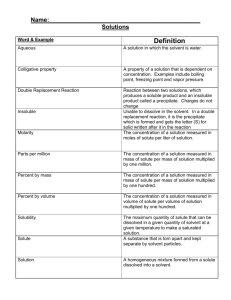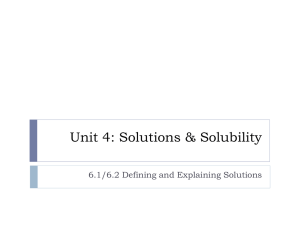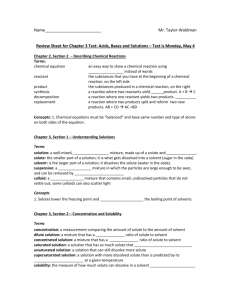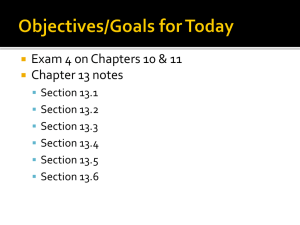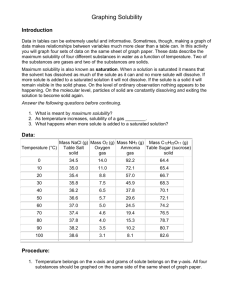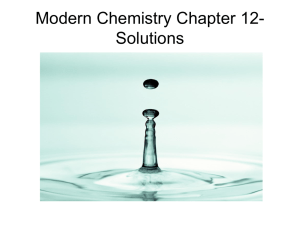Solutions
advertisement
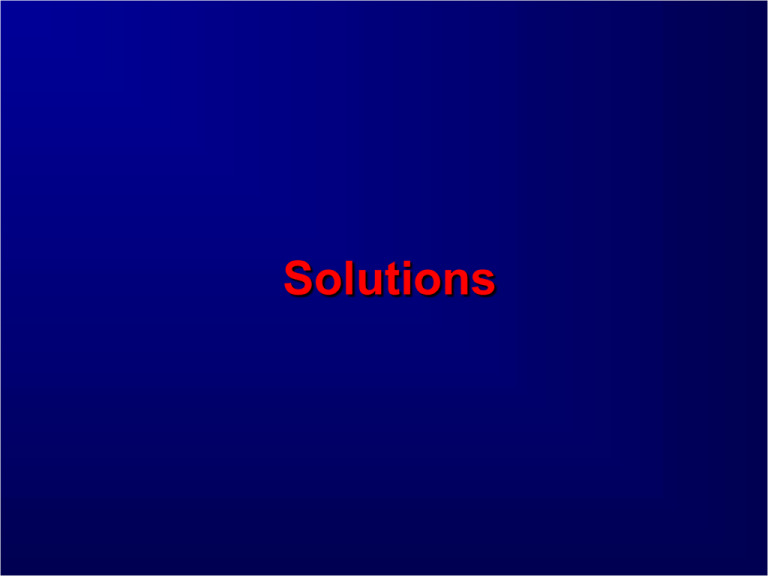
Solutions SOLUTE + SOLVENT SOLUTION State of Matter Gas: homogenous mixture of gases (Air…) Liquid: solvent: liquid solute: gas solid (soda water: CO2/H2O; brine: NaCl/H2O) solvent: liquid solute: liquid (ethanol in water) Solid: solvent: solid (gold-silver alloy) solute: solid solvent: solid (Dental-filling alloy) solute: liquid Terms to Know… Dissolve: solute + solvent solution. Crystallization: solution solute + solvent. Saturation: crystallization and dissolution are in equilibrium. Solubility: amount of solute required to form a saturated solution. Supersaturated: a solution formed when more solute is dissolved than in a saturated solution. Miscible: two liquids that mix. Immiscible: two liquids that do not mix. Like Dissolves Like “Rule”: polar solvents dissolve polar solutes. Non-polar solvents dissolve non-polar solutes. Why? + – + – – + – + + – + – NaCl If ΔHsoln is too endothermic a solution will not form. NaCl in octane (C8H18): the ionLondon forces are weak because octane is non-polar. Therefore, the ion-London forces do not compensate for the separation of ions. NaCl dissolves nicely in water. octane water Terminology: Solubility: is the maximum amount of the solute that will dissolve in a definite amount of solvent (at a given t°) g/100 mL Concentration: ratio of the solute and the solvent Dilute solutions Concentrated solutions Saturated solutions: solutepure solute dissolved Supersaturated solutions: g/100 mL KNO3 PbCl2 NaCl Solubility curves t° Temperature Effects: Solids • Experience tells us that sugar dissolves better in warm water than cold. • As temperature increases, solubility of solids generally increases. • Sometimes, solubility decreases as temperature increases (e.g. Ce2(SO4)3). Properties of Water Most abundant liquid Vital to life Universal solvent 1. High melting and boiling points M.p.: 0.0°C B.p.: 100.0°C (0.1 MPa) Hydrogen Bonding Special 150 H2 O 100 Group 4 Group 5 Boiling Point (deg C) case of dipole-dipole forces. By experiments: boiling points of compounds with H-F, H-O, and H-N bonds are abnormally high. Intermolecular forces are abnormally strong. 50 Group 6 Group 7 0 H2S e H2 S -50 -100 SnH 4 GaH SiH -150 H2T e 4 4 CH -200 4 0 1 2 3 Period 4 5 Water Molecule Solutions Phase Diagram of H2O The melting point curve slopes to the left because ice is less dense than water. Triple point occurs at 0.0098°C and 4.58 mmHg. Normal melting (freezing) point is 0°C. Normal boiling point is 100°C. Critical point is 374°C and 218 atm. 2. Density 0.0°C (ice) 0.0°C (liquid) 3.98°C 25.0°C 3. Surface tension: 0.91680 g/cm3 0.99984 g/cm3 0.99997 g/cm3 0.99704 g/cm3 high Bottom of meniscus 4. High heat of vaporization 40.70 kJ/mol 5. High heat of fusion 6.02 kJ/mol 6. High specific heat 75.20 kJ/mol 1. Chemically pure water 2. Water of crystallization or hydration CuSO4 5H2O(s) D CuSO4(s) + 5H2O(g) (CaSO4)2 H2O (plaster of paris) CaSO4 2H2O (gypsum) Na2CO3 10H2O 3. Groundwater Cations Anions Ca2+ HCO3-, CO32- Na+ OH- Mg2+ SO42- K+ Cl- Fe2+, Fe3+ NO3- NH4+ F-, PO43- Hard water Soft water Temporary hard water HCO3- (bicarbonate) Permanent hard water Water Softening Boiling Softening agents Distillation Ion-exchange Mineral water Thermal water precipitation complex formation



